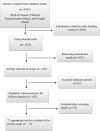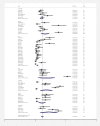Evaluation of the Presence of Bacterial and Viral Agents in the Semen of Infertile Men: A Systematic and Meta-Analysis Review Study
- PMID: 35602502
- PMCID: PMC9116196
- DOI: 10.3389/fmed.2022.835254
Evaluation of the Presence of Bacterial and Viral Agents in the Semen of Infertile Men: A Systematic and Meta-Analysis Review Study
Abstract
Objectives: Infections in the male genitourinary system with bacterial and viral agents may play a significant role in male infertility. These agents usually infect the urethra, seminal vesicles, prostate, epididymis, vas deferens, and testes retrograde through the reproductive system. A meta-analysis review study was performed to evaluate the presence of bacterial and viral agents in the semen of infertile men and its correlation with infertility.
Methods: Relevant cross-sectional and/or case-control studies were found by an online review of national and international databases (Web of Science, PubMed, Scopus, Science Direct, and Google scholar), and suitable studies were selected. A checklist determined the qualities of all studies. Heterogeneity assay among the primary studies was evaluated by Cochran's Q test and I2 index (significance level 50%). A statistical analysis was conducted using the Comprehensive Stata ver. 14 package (StataCorp, College Station, TX, United States).
Results: Seventy-two studies were included in this meta-analysis. Publication bias was compared with Egger's test, and the impact of each research on overall estimate was evaluated by sensitivity analysis. In 56 studies, the rate of bacterial infections in the semen of infertile men was 12% [95% confidence interval (CI): 10-13]. Also, in 26 case-control studies, the association of infertility in men with bacterial infections was evaluated. The results show that the odds ratio of infertility in men exposed to bacterial infections is 3.31 times higher than that in non-infected men (95% CI: 2.60-4.23). Besides, in 9 studies that examined the prevalence of human papillomavirus (HPV), herpes simplex virus 1 (HSV1), herpes simplex virus 2 (HSV2), and herpes simplex virus 1-2 (HSV1-2) in infertile men, the frequency of these viruses was 15% (95% CI: 9-21). In 6 case-control studies, the association between human cytomegalovirus (HCMV), Cytomegalovirus (CMV), and HPV and male infertility was evaluated. The chance of male infertility due to exposure to these viruses was 2.24 times higher than those without exposure to these viruses (CI 95%: 1.9-4.52). The results show that the chance of infertility in men exposed to bacteria was significantly higher than that in the uninfected population.
Conclusion: This meta-analysis showed that viral and bacterial infections are a risk factor and could impair male fertility potential. Moreover, our study supports the hypothesis that bacterial and viral infections of the genital tract correlate positively with impairment of sperm quality in the male population.
Keywords: Iran; bacteria; infection; infertility; semen; virus.
Copyright © 2022 Gholami, Moosazadeh, Haghshenash, Jafarpour and Mousavi.
Conflict of interest statement
The authors declare that the research was conducted in the absence of any commercial or financial relationships that could be construed as a potential conflict of interest.
Figures









Similar articles
-
The Impact of Herpes Simplex Virus on Semen Parameters in Men with Idiopathic Infertility: A Systematic Review.Int J Fertil Steril. 2023 Apr 1;17(3):152-159. doi: 10.22074/ijfs.2022.552037.1289. Int J Fertil Steril. 2023. PMID: 37183841 Free PMC article.
-
Seminal human papillomavirus infection and reproduction: a systematic review and meta-analysis.Andrology. 2021 Mar;9(2):478-502. doi: 10.1111/andr.12948. Epub 2020 Dec 11. Andrology. 2021. PMID: 33220146
-
Relative frequency of hepatitis B virus, human papilloma virus, Epstein-Barr virus, and herpes simplex viruses in the semen of fertile and infertile men in Shiraz, Iran: A cross-sectional study.Int J Reprod Biomed. 2021 Sep 9;19(8):699-706. doi: 10.18502/ijrm.v19i8.9617. eCollection 2021 Aug. Int J Reprod Biomed. 2021. PMID: 34568730 Free PMC article.
-
Impact of human papillomavirus infection in semen on sperm progressive motility in infertile men: a systematic review and meta-analysis.Reprod Biol Endocrinol. 2020 May 7;18(1):38. doi: 10.1186/s12958-020-00604-0. Reprod Biol Endocrinol. 2020. PMID: 32381092 Free PMC article.
-
Prevalence of HSV-1/HSV-2 and CMV Infections in Infertile Men and Their Impact on Sperm Parameters: A Cross-Sectional Study in Iran.Health Sci Rep. 2025 Feb 11;8(2):e70221. doi: 10.1002/hsr2.70221. eCollection 2025 Feb. Health Sci Rep. 2025. PMID: 39935842 Free PMC article.
Cited by
-
The Impact of Herpes Simplex Virus on Semen Parameters in Men with Idiopathic Infertility: A Systematic Review.Int J Fertil Steril. 2023 Apr 1;17(3):152-159. doi: 10.22074/ijfs.2022.552037.1289. Int J Fertil Steril. 2023. PMID: 37183841 Free PMC article.
-
Human cytomegalovirus UL82 promotes cell cycle progression of colorectal cancer by upregulating AGR2.Commun Biol. 2025 Feb 17;8(1):251. doi: 10.1038/s42003-025-07674-z. Commun Biol. 2025. PMID: 39962326 Free PMC article.
-
Update on known and emergent viruses affecting human male genital tract and fertility.Basic Clin Androl. 2024 Mar 14;34(1):6. doi: 10.1186/s12610-024-00222-5. Basic Clin Androl. 2024. PMID: 38486154 Free PMC article. Review.
-
Semen HPV and IVF: insights from infection prevalence to embryologic outcomes.J Assist Reprod Genet. 2025 Jun;42(6):2053-2066. doi: 10.1007/s10815-025-03513-6. Epub 2025 May 22. J Assist Reprod Genet. 2025. PMID: 40402400 Free PMC article.
-
Strategies for Bacterial Eradication from Human and Animal Semen Samples: Current Options and Future Alternatives.Sensors (Basel). 2023 Aug 6;23(15):6978. doi: 10.3390/s23156978. Sensors (Basel). 2023. PMID: 37571761 Free PMC article. Review.
References
-
- Bukharin O, Kuz’min M, Ivanov I. The role of the microbial factor in the pathogenesis of male infertility. Zh Mikrobiol Epidemiol Immunobiol. (2000). 2:106–10. - PubMed
Publication types
LinkOut - more resources
Full Text Sources

